Scottish Health Survey 2016 - volume 1: main report
Statistics relating to the health of people living in Scotland.
3. Physical Activity
Eilidh Currie
Summary

- Younger age groups continued to be more likely than older age groups to meet the MVPA guidelines (75-76% of those aged 16-44, compared to 30% of those aged 75 and over).
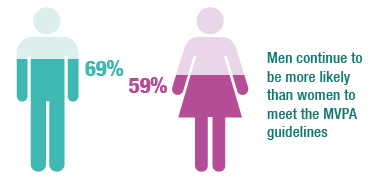

- Younger children were more likely than older children to meet the physical activity guidelines, (82% of 5-7 yearolds doing so, compared with 61% of those aged 13-15, school-based activity included).
- In 2016, 68% of children had participated in sport and exercise in the week prior to the interview, this has been relatively stable since 2010 but fluctuated in previous survey years with the highest level seen in 2009 (73%).
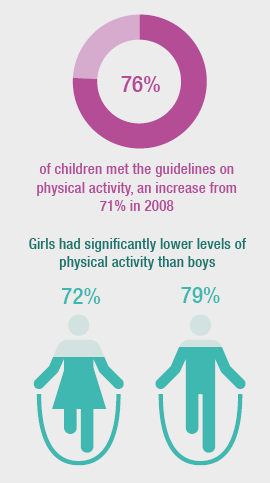
3.1 Introduction
There is widespread consensus around the evidence base for the health, economic and social benefits of physical activity with strong scientific evidence that sufficient, regular physical activity is beneficial for the health of body and mind. Physical activity improves the health of the heart; skeletal muscles; bones; blood; immune system and nervous system. Physical activity also improves psychological wellbeing; self-perception and self-esteem; and mood and sleep quality[1].
Furthermore, there is clear evidence that physical activity reduces the risk of over twenty five chronic health conditions, including coronary heart disease, stroke, type 2 diabetes, cancer, obesity, mental health problems and musculoskeletal problems, and has secondary prevention benefits for many others[2].
We also know that physical inactivity shortens life expectancy. The most recent global estimate is that inactivity is responsible for 9% of premature deaths, or 5.3m of the 57 million deaths that occurred worldwide in 2008[3]. Physical inactivity is estimated to kill around 2,500 Scots each year and cause direct costs to the NHS of around £91m per year[4].
Physical activity is particularly important for older populations and their ability to maintain functional independence[5]. Many activities of daily living, such as getting out of a chair, or climbing stairs, do not necessarily require significant aerobic fitness, but do require musculoskeletal fitness (i.e. muscle strength, endurance, power and flexibility) that improves balance, can help prevent or delay the onset of functional limitations, improve functional ability, and reduce falls.
In addition to physical function, there is evidence that physical activity contributes to the maintenance of cognitive function in older adults[6]. Physical activity delays the incidence of dementia and the onset of cognitive decline associated with ageing. A more active older population will be better able to live independently.
The UK Chief Medical Officers’ guidelines on recommended amounts of physical activity for adults were issued in 2011[7]. Broadly, in adults, there is a dose-response relationship between physical activity and health, meaning greater benefits occur with greater participation. The largest reductions in disease risk occur at the lower end of the spectrum, implying the greatest benefits from a population health perspective arise from moving from inactivity to some level of activity. The available evidence to date on levels of activity suggests that any is better than none, some is good, and more is better[8].
Table 3A UK CMO physical activity guidelines (2011)
| Age group | Guidelines |
| Early years – children under 5 years |
|
| Children and young people aged 5 to 18 |
|
| Adults aged 19-64 |
|
| Adults aged 65 and over |
|
3.2 Policy Background
In common with many developed societies, Scotland faces increasing challenges to public health arising from lifestyle behaviours, wider social-cultural factors that prevent positive health choices being made and a modern environment that impacts on the health and wellbeing of individuals, families and communities.
We know that the drivers of good health are for the most part in our homes, schools and communities and that improving public health means creating the conditions where people have the hope and purpose to think better choices are available to them. That means looking to the deep-rooted causes of social and economic inequality which result in children born into Scotland’s most deprived communities being likely to live for 20 fewer years in good health. It also means recognising that improving public health will require concerted effort across the whole of society.
The Scottish Government Health and Social Care Delivery Plan (2016)[9] emphasises the requirement for a concerted, sustained and comprehensive approach to improving population health through targeting particular health behaviours, acting to reduce avoidable harm and illnesses and taking a population and whole life approach to prevention and early intervention.
The Scottish Government’s vision is for a Scotland where physical activity is a routine part of everyone’s daily life whether that is through walking or cycling to work, school, or to the shops, through gardening or dance, through active play or formal sport, or through any activities which result in Scots sitting less and moving more.
The Active Scotland Outcomes Framework[10], published in 2014, sets out the Scottish Government’s ambitions for a more active Scotland. The Framework aims to help to bring both a common language to this landscape and also encapsulate the best of international research. Progress towards the achievement of the Framework has been made through a range of activities across sectors through the implementation of a the National Walking Strategy[11] Cycling Action Plan[12] Active Schools programme[13], Community Sports Hubs and Legacy 2014 Physical Activity Fund[14]. The Scottish Government has committed to expanding the Daily Mile[15] to ensure that Scotland becomes the first ‘Daily Mile nation’ with roll out to nurseries, schools, colleges, universities and workplaces. The ‘Care About…Physical Activity’[16] programme is also being extended to provide greater support for older people in care to be physically active.
3.2.1 Reporting on physical activity in the Scottish Health Survey
Adult adherence to the guidelines on moderate / vigorous physical activity (MVPA) is presented in this chapter along with sport participation levels. Trends in child physical activity, both including and excluding school-based activities, and in child participation in sports and exercise are also presented. These headline measures are key indicators for a number of strategies.
The area deprivation data for physical activity are presented in Scottish index of Multiple Deprivation (SIMD) quintiles. To ensure that the comparisons presented are not confounded by the different age profiles of the quintiles, the data have been age-standardised. Readers should refer to the Glossary at the end of this Volume for a detailed description of SIMD and age-standardisation.
Supplementary tables on physical activity are available on the survey website[17].
3.3 Methods And Definitions
3.3.1 Adult physical activity questionnaire
The SHeS questionnaire[18] asks about four main types of physical activity:
- Home-based activities (housework, gardening, building work and DIY)
- Walking
- Sports and exercise
- Activity at work.
Information is collected on the:
- time spent being active
- intensity of the activities undertaken
- frequency with which activities are performed.
3.3.2 Adherence to adult physical activity guidelines
Monitoring adherence to the revised guidelines (discussed in Section 3.1) required several changes to be made to the SHeS physical activity questions in 2012. Details of the amendments made to the module, and fuller details of the information collected about physical activity, are outlined in the 2012 SHeS annual report[19].
The current activity guidelines advise adults to accumulate 150 minutes of moderate activity or 75 minutes of vigorous activity per week or an equivalent combination of both, in bouts of 10 minutes or more. These guidelines are referred to throughout this chapter as the MVPA guidelines (Moderate or Vigorous Physical Activity). To help assess adherence to this guideline, the intensity level of activities mentioned by participants was estimated. Activities of low intensity, and activities of less than 10 minutes duration, were not included in the assessment. This allowed the calculation of a measure of whether each SHeS participant adhered to the guideline, referred to in the text and tables as “adult summary activity levels”. A more detailed discussion of this calculation is provided in the 2012 report[19].
Table 3B Adult summary activity levelsa
| Meets MVPA guidelines | Reported 150 mins/week of moderate physical activity, 75 mins vigorous physical activity, or an equivalent combination of these. |
| Some activity | Reported 60-149 mins/week of moderate physical activity, 30-74 mins/week vigorous physical activity, or an equivalent combination of these. |
| Low activity | Reported 30-59 mins/week of moderate physical activity, 15-29 mins/week vigorous physical activity or an equivalent combination of these. |
| Very low activity | Reported less than 30 mins/week of moderate physical activity, less than 15 mins/week vigorous physical activity, or an equivalent combination of these. |
a Only bouts of 10 minutes or more were included towards the 150 minutes per week guideline
To avoid overcomplicating the text, where descriptions are provided of the summary activity levels, they tend to refer only to moderate physical activity, although the calculations were based on moderate or vigorous activity as described above.
3.3.3 Child physical activity questionnaire
The questions on child physical activity are slightly less detailed than those for adults[20]. No information on intensity is collected (with the exception of asking those aged 13-15 about their walking pace). The questions cover:
- Sports and exercise
- Active play
- Walking
- Housework or gardening (children aged 8 and over only).
Children were asked to provide information on the average duration of sports and exercise activities for a typical weekday and typical weekend day. They were not asked to differentiate between different weekday or weekend days or to provide a specific duration for each separate day.
Since 2008, children at school have also been asked about any active things they have done as part of lessons (using the same format of questions as for all other activity types). Full details of all the information collected was provided in the 2012 report[19].
3.3.4 Adherence to child physical activity guidelines
For the purposes of calculating physical activity levels, it was assumed that all reported activities were of at least moderate intensity. Data on each of the different activities have been summarised to provide an overall measure of child physical activity. This summary measure takes into account both the average time spent participating in physical activity, and the number of active days in the last week. Each child’s level of physical activity was assigned to one of three categories:
Table 3C Child summary activity levels
| Meets guideline | Active on 7 days in last week for an average of at least 60 minutes per day |
| Some activity | Active on 7 days in last week for an average of 30 to 59 minutes per day |
| Low activity | Active on fewer than 7 days in last week or for an average of less than 30 minutes a day |
From the start of 2017, the amount of activity the child undertook on each day of the week has been collected. As such, the report of the 2017 data, (to be published next year) will present children’s adherence to the physical activity guidelines on two bases: a) an average of at least 60 minutes per day (as in this report) and b) at least 60 minutes on every day.
3.4 Adult Physical Activity Levels
3.4.1 Summary activity levels since 2012
In 2016, almost two-thirds (64%) of adults met the guidelines for moderate or vigorous physical activity (MVPA) of at least 150 minutes of moderate physical activity, 75 minutes vigorous physical activity, or an equivalent combination of the two, per week. Furthermore, 11% of adults reported some physical activity, 5% reported low levels and 20% reported very low levels. As illustrated in Figure 3A, the proportion of all adults meeting the guidelines has not changed significantly since 2012, ranging from 62-64%.
Men remained significantly more likely than women to meet the MVPA guidelines in 2016 (69% compared with 59%), with some fluctuation for both men and women since 2012.
Figure 3A, Table 3.1
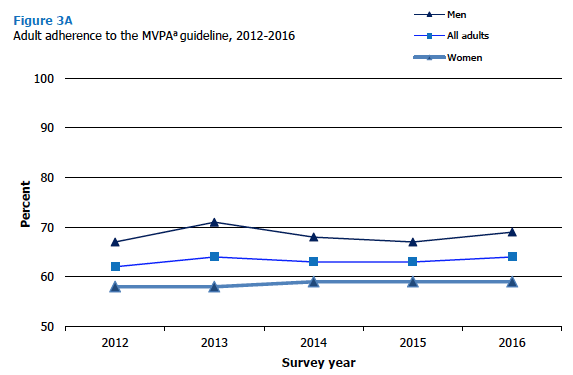
aMeets moderate/vigorous physical activity guideline of 150 minutes of moderate, 75 minutes vigorous, or combination of both each week
3.4.2 Summary adult physical activity levels, 2016, by age and sex
Physical activity levels among adults were significantly associated with age, with younger age groups more likely than older age groups to meet the MVPA guidelines. Adherence to the guidelines was highest among those aged 16-44 (75-76%) and declined from 67% among those aged 45-54 to 30% among adults aged 75 and over. The pattern by age was similar for men and women.
The decline in activity levels by age among both men and women corresponded to increasing levels of very low activity (less than half an hour a week of moderate activity or the equivalent level of vigorous activity) as age increased. Though there was little variation in the proportion of adults undertaking ‘some activity’ or ‘low activity’ across the age groups, the proportion with very low activity levels increased from a range of 9-11% among those in the three youngest age groups (16-44) to 51% among those aged 75 and over.
As shown in Figure 3B, across all age groups men’s physical activity levels were higher than women’s. The difference between men and women’s adherence to the MVPA guidelines was most evident among the youngest and oldest age groups: 82% of men aged 16-24 met the guidelines compared with 68% of women of the same age (14 percentage points difference); and 39% of men aged 75 and over met the guidelines compared with 24% of women of that age (15 percentage points difference). The difference was smallest, and not statistically significant, between men and women aged 55-64 (four percentage points).
Figure 3B, Table 3.2
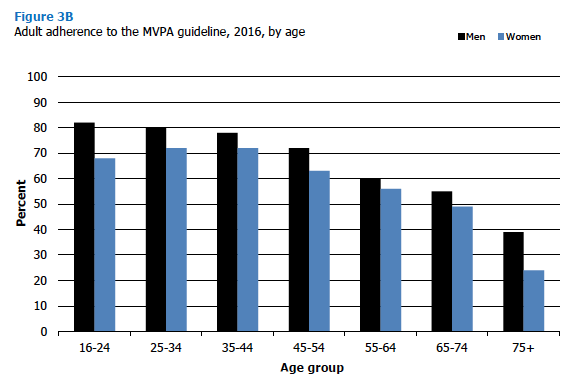
3.4.3 Summary adult physical activity levels, 2016, by area deprivation and sex
Adult physical activity levels were significantly associated with area deprivation. As Figure 3C shows, the age-standardised prevalence of adherence to the MVPA guidelines was highest among adults in the least deprived areas at 74%, and steadily declined with increasing deprivation to 54% among adults in the most deprived areas.
This pattern was true for both men and women, with the decline being greater for women than for men. For men, the age-standardised prevalence of adherence to the MVPA guidelines declined from 77% in the least deprived areas to 61% in the most deprived areas. Among women, the age-standardised prevalence of adherence to the MVPA guidelines declined from 71% to 48%.
Similar to the pattern observed for age, the decline in adherence to the MVPA guidelines as deprivation increased largely corresponded to the increasing levels of very low activity. The percentage of those with very low activity levels increased from 13% in the least deprived areas to 29% in the most deprived areas. Meanwhile, there was little variation in the proportion of those undertaking ‘some activity’ (9-12%) or ‘low activity’ (4-6%) across the quintiles. These patterns were evident for both sexes.
Figure 3C, Table 3.3
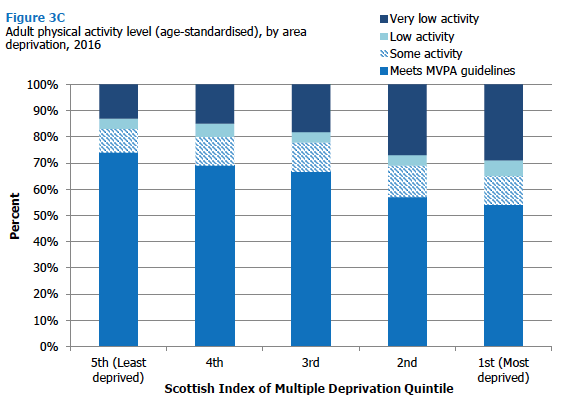
3.4.4 Adult sport participation in 2016, by age and sex
In 2016, 56% of adults had participated in sport and/or exercise during the four weeks prior to interview. The most popular activities reported included working out at a gym (17%), exercises (16%), swimming (13%), running/jogging (12%), hillwalking/rambling and cycling (both 10%).
There were significant differences in sport participation between men and women. Men were more likely than women to have participated in sport and/or exercise during the last four weeks (62% and 51% respectively). Furthermore, there were variations in the most popular activities reported between the sexes. For example, men were more likely than women to have participated in running, cycling, football/rugby and golf, whereas women were more likely to have participated in swimming, yoga/pilates and aerobics / keep fit / gymnastics / dance. Activities such as badminton, hillwalking / rambling, and basketball were equally popular among men and women.
The proportion of adults taking part in any sport and/or exercise during the four weeks prior to interview also varied significantly by age. As Figure 3D illustrates, 78% of those aged 16-24 had participated in any sport and/or exercise during the last four weeks, this then declined steadily to 30% among those aged 75 and over. This trend was observed for both men and women.
In addition, for the majority of types of sports, participation declined with age, with the exception of bowls, fishing / angling and golf, for which participation levels remained broadly steady or increased with increasing age.
Figure 3D, Table 3.4
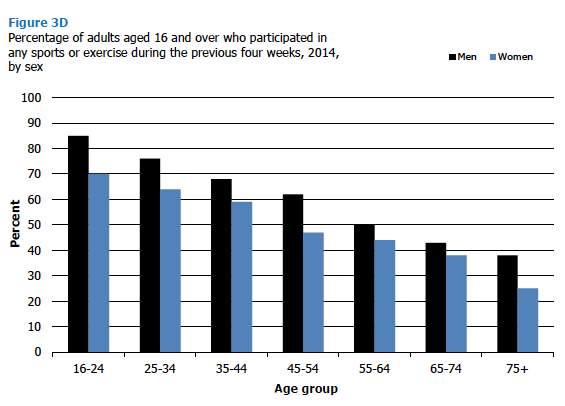
3.5 Child Physical Activity Levels
3.5.1 Proportion of children meeting physical activity guideline since 1998
Information on children’s physical activity has been collected in SHeS since 1998, and physical activity carried out while at school has been collected since 2008. The proportion of children aged 2-15 meeting the physical activity guideline of 60 minutes of activity per day[21], including and excluding activity at school, from 1998 to 2016 are presented in Figure 3E.
Just over three quarters (76%) of children aged 2-15 were active at the recommended level (including activity at school) in 2016, representing a statistically significant increase of five percentage points since 2008. This general trend of increased physical activity levels (including activity at school) was apparent for girls where it increased from 64% in 2008 to 72% in 2016. For boys the trend pattern was less clear fluctuating between 73% and 79% during the time period.
When school-based activities are excluded, 68% of children aged 2-15 met the guideline on physical activity in 2016. The long term trend has not shown a significant difference from 1998 (65%) to 2016 (68%), and has fluctuated over that time period. This pattern of fluctuation was apparent for both boys and girls. Boys have been more likely to meet the guidelines than girls since 1998.
Figure 3E, Table 3.5
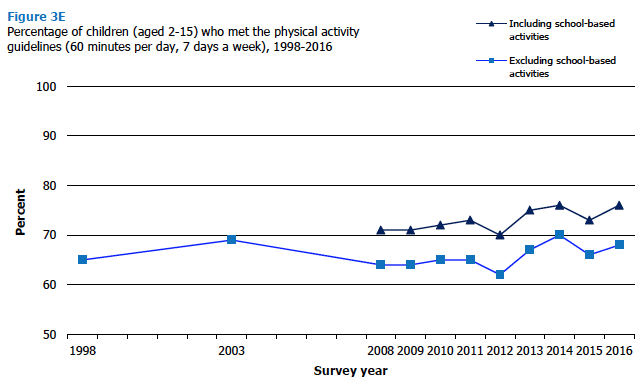
3.5.2 Physical activity levels in children in 2016, by age and sex
Children’s physical activity levels varied significantly by age, with younger children more likely than older children to meet the physical activity guideline. When school-based activity was included, the proportion of children meeting the guideline was highest for those aged 5-7 (82%). Adherence then declined steadily with increased age, to 61% for those aged 13-15. This pattern was also observed when school-based activity was excluded, although the decline in activity was more pronounced. The proportion of those meeting the physical activity guideline was highest in the youngest age group (77%) and declined to 48% for those aged 13-15.
The pattern by age was significantly different for boys and girls both when school-based activities were included and excluded. Among boys the proportion meeting the physical activity guidline including activity at school peaked at 86% for those aged 11-12 before declining sharply to 72% of those aged 13-15. Among girls the rate was highest for those aged 5-7 (81%) and declined to 49% for those aged 13-15. When activity at school is excluded a different pattern by age is also apparent when examing boys and girls separately. The proportion of boys meeting the guidelines fluctuated between 73% and 78% from ages 2-12 before declining sharply to 58% for those in the oldest age group (aged 13-15). For girls the decline by increasing age started at age 11-12 where it had dropped from 73% among those aged 8-10 to 53% for 11-12 year olds, and further dropped to 36% for those aged 13-15.
As Figures 3F and 3G illustrate the significant difference in activity levels between boys and girls was largely explained by differences in the older age groups (11-12 and 13-15). Girls in those age groups had significantly lower levels of physical activity compared with boys, both when activity at school was included and excluded. There was a nine percentage point gap overall between boys (73%) and girls (64%) when school-based activity was excluded, which rose to 25 percentage points for those aged 11-12 and 22 percentage points for those aged 13-15. This pattern of lower activity levels among girls aged 11-12 and 13-15 was also observed when school-based activity was included, and in part explains why boys were significantly more likely than girls to meet the guideline overall. Levels of physical activity were more similar for boys and girls in the other age groups.
Figure 3F, Figure 3G, Table 3.6
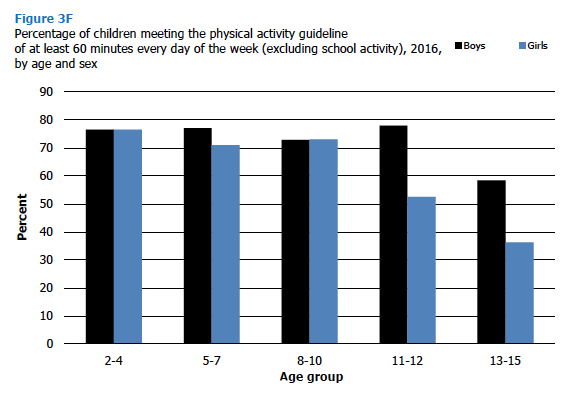
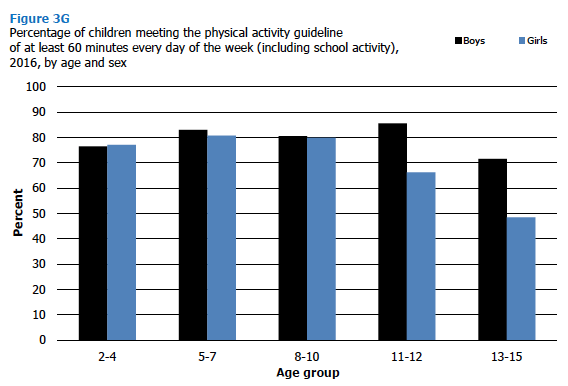
3.5.3 Physical activity levels in children, 2016, by area deprivation and sex
Children's physical activity levels varied by area deprivation, although there was no clear pattern of association.
As illustrated in Figure 3H, adherence to the physical activity guideline when school-based activities were included was highest among children in the 3rd quintile of area deprivation (81%) and lowest among children in the most deprived quintile (70%). Similarly when school-based activities were excluded, adherence to the physical activity guideline was highest for children in the 3rd quintile (77%) and lowest for children in the most deprived quintile (61%).
This pattern was similar for boys and girls. Among boys, the prevalence of adherence to the physical activity guideline (including school-based activities) was highest in the 5th (least deprived) and 3rd quintile (both 84%) and lowest in the most deprived areas (72%). For girls prevalence was highest in the 3rd quintile (78%) and lowest in the 4th quintile (66%). These patterns were similar when school-based activities were excluded.
Figure 3H, Table 3.7

3.5.4 Percentage of children participating in sport, 1998 to 2016
In 2016, 68% of children aged 2-15 had participated in sport in the week prior to interview, continuing the relatively stable trend since 2010 (ranging between 70% and 66%) following a drop from 73% in 2009.
Sport participation rates in 2016 were similar for boys and girls (70% and 67% respectively). The sports participation level among boys has remained relatively stable since 2012 (between 67% and 71%) following a decrease from 76% in 2009. Similarly to boys, the level of girls participation in sport in the previous week was at its highest in 2009 (70%) with levels fluctuating between 63% and 67% since.
Figure 3I, Table 3.8
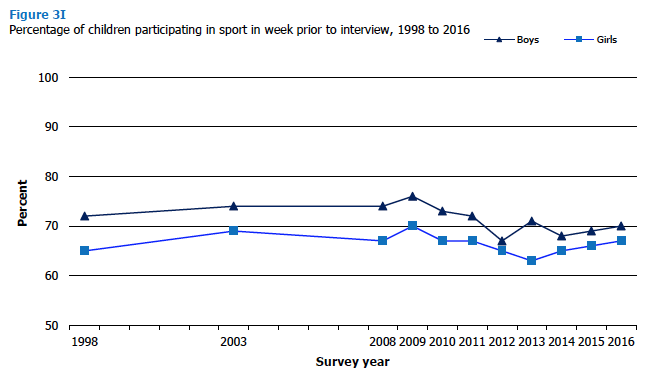
Contact
Email: Julie Landsberg, Julie Landsberg
Phone: 0300 244 4000 – Central Enquiry Unit
The Scottish Government
St Andrew's House
Regent Road
Edinburgh
EH1 3DG
There is a problem
Thanks for your feedback
